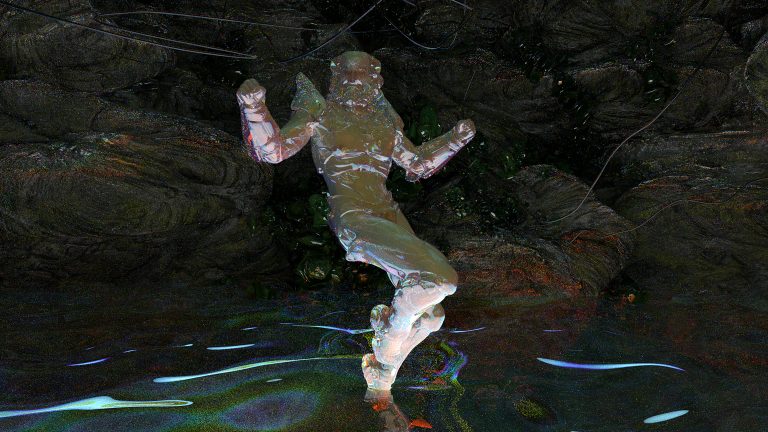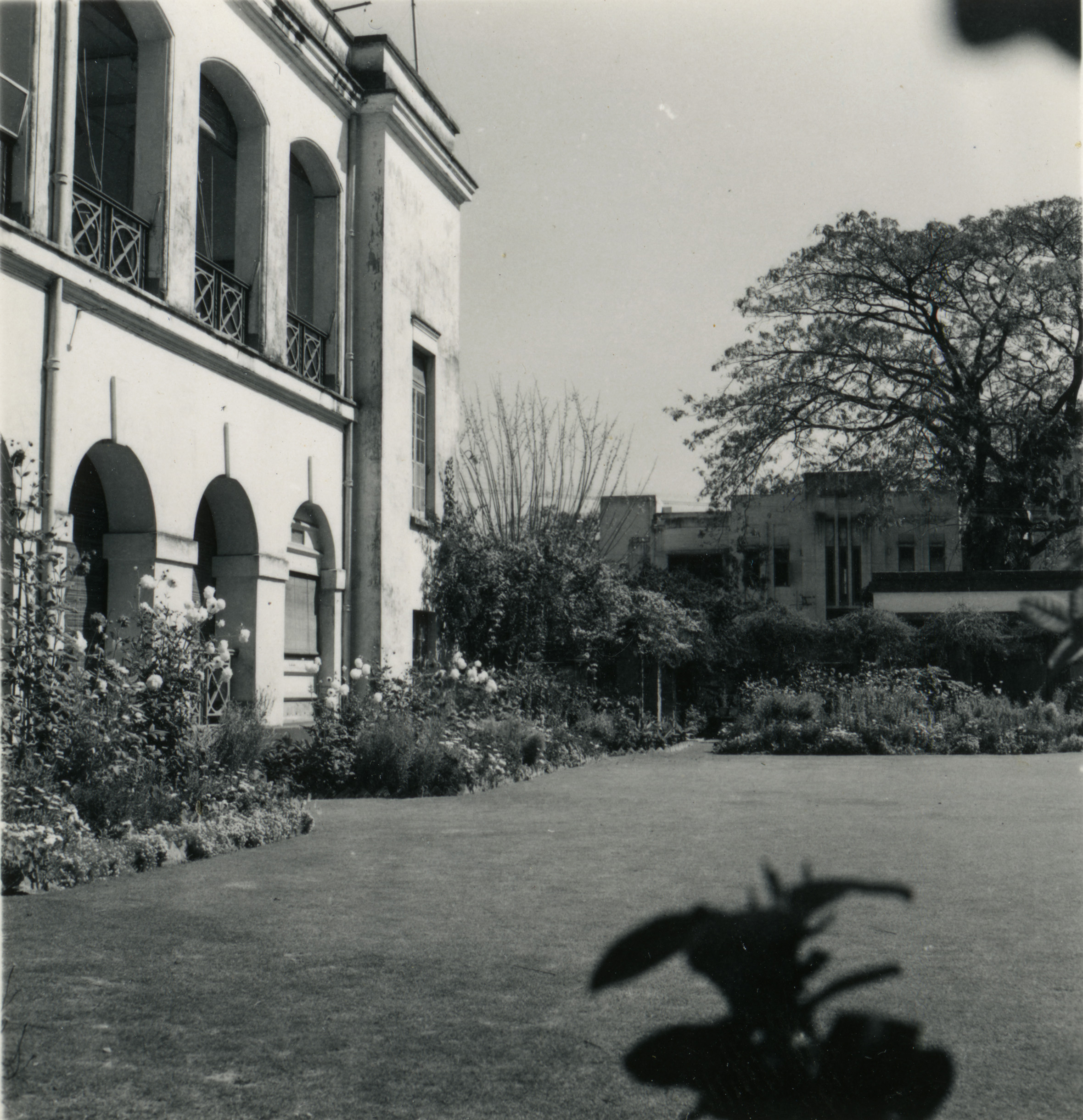Dennis McNulty’s The Driver and the Passenger at first seems to be a continuation of a recent installation piece titled Between motion and Static Mass. Broadly, Between motion and Static Mass was an installation piece, created for a location on the sixth floor of a multi-storey car-park (parking garage) in the centre of Kilkenny town, involving a parked courier van, with its doors open and its cargo of modular, tubular-steel notice boards assembled nearby.
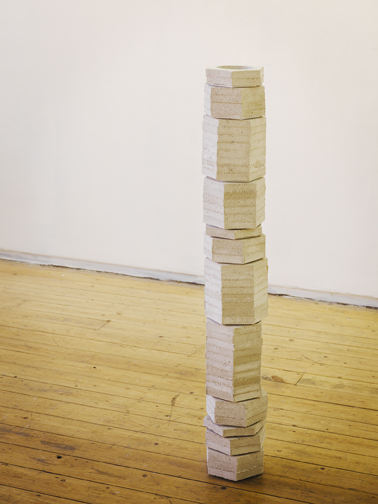
Dennis McNulty: Alternative proposal for Collingwood (Moffett #1) (2010),
concrete, aluminium and acrylic;
image courtesy Green on Red Gallery. Photo: Ros Kavanagh.
As a point of continuity, on the top steps of the stairway to the Green on Red gallery foyer sit two small black speakers from which issues a voice, in a vehicle, reading aloud the road signs as they are encountered on the way into a place called Breezewood. This audio piece Approaching Breezewood charts the route into an unincorporated town on the Pennsylvania Turnpike.[1] The utterances at first seem random, but they slowly develop a sort of linear landscape of familiar non-places like: “Best Western at second light on right, Big Fish Transport, Family House Prime rib,” et cetera. The name of this town has the generic sound of one of those dreamt up by the marketing departments of housing development companies.
On the landing sits a modular, self-supporting, stainless steel shelf, upon which sits a projector beaming an abstract geometric animation onto a folded-over copy of The Guardian newspaper. The animation of strobe lines reveals and connects different nodes in a plumb-less black field, then disappears, reappears, speeds up, quakes – all the while shifting, elusive, re-iterating and re-framing these nodes of connection. This work titled Destination, plays out, wittily, onto a specific article in The Guardian newspaper, which reports on a cosmological finding involving an Earth-like planet called Gilese 581g, that lies squarely in the region of space where life can thrive. [2]
Conversely, Box with the sound of our own unmaking sits flush with the entrance to the main gallery space and from it emanates the sounds of a traffic jam. These sounds evoke a 1950’s science fiction radio play, a ring-road around a Ballardian High Rise, a future anterior shift. The machine creating the sounds is, as the title suggests, boxed off – in a facetted plywood structure, which is too tall to peer into. This not only introduces the viewer to the immediacy of one’s relative scale to the box, but it also forcefully thrusts the viewer into the role of listener.
The Driver and the Passenger could suggest two specific roles: the knowing, dominant driver and the ignorant, passive passenger. However, as the work unfolds it becomes clear that the passenger/spectator is asked to look, connect, be active, as anybody is, thus removing the idea of a gap between the two positions.[3]
On a flat-screen television, which sits proud of the wall, a video piece loops, it having been shot from the outside of a modernist residence in New Canann, Connecticut. The reflections of passers-by on the glazed external façade, combined with the sun beaming through the building – revealing the eerily, almost show-house domestic order within – and the short loop time of the piece, creates at once a sumptuous, shifting and disorientating effect.
Inside this building, what looks like a Mies van der Rohe Barcelona Chair can be seen. Van der Rohe was a long time collaborator and friend of Phillip Johnson, the architect of this seminal Glass House. [4]
Furthering this Johnson–Van der Rohe connection, the sculptural piece Alternative proposal for Collingwood (Moffett #1) at first looks like an elongated Barcelona table. (A Barcelona table was a minimalist table design by van der Rohe that comprised of a tubular steel structure holding a glass table-top). However, the scale of the sculptural piece and the height of its glass “table-top”, brings the work from the realm of furniture into the realm of the architectural model – albeit an abstract model with an indicative subsurface structure. The steel sub-structure has the appearance of a distorted hexagon through the middle of which ruptures a rhombus shaped shaft.
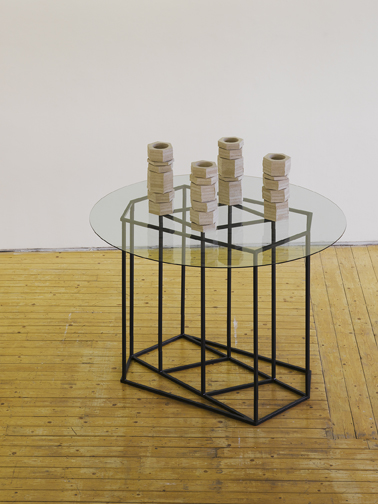 Dennis McNulty: Alternative proposal for Collingwood (Moffett #2), (2010)
Dennis McNulty: Alternative proposal for Collingwood (Moffett #2), (2010)
Concrete, aluminium, acrylic, mild-steel and glass, unique;
image courtesy the Green on Red Gallery. Photo: Ros Kavanagh.
Sitting upon the glazed surface are four towers, in line with the four points of the rhombus. The towers are comprised of modular, hexagonal pieces of cast concrete placed one on top of the other with slices of acrylic and aluminium in between.
The title of the piece alludes to a little known and lesser-documented social housing project in London, built in the 60s and designed by the now deceased Irish architect and teacher Noel Moffett.[5] Where van Der Rohe and Johnson are internationally recognised and revered, Moffett and Alina (his wife and collaborator) are not generally known today.[6] In Alternative proposal for Collingwood (Moffett #1), (Collingwood are the management agency now handling this old social housing project) McNulty re-words the almost obsessive use of the space efficient hexagon employed by Moffett in the design. The recognition of this obscure Irish architect is a worthy gesture.
Deposited on the floor nearby is a dismantled tubular steel frame, around which is loosely tied a blue ratchet strap. One tries to fit the pieces together as they lie there – as if in the back of a courier’s truck, in transit from another place. It is a forlorn object. It illustrates the need for a destination or place, for it to be finally articulated and used, however temporarily.
On the left and right hand walls of the gallery are a series of photographs, placed continuously side by side, of a closed down, pink-walled furniture store in Dublin. The images titled Factory Prices Guaranteed, have been taken in the recent past and from the top of a double-decker bus, while it was either in motion or stationary. These images produce a number of narratives: that of the furniture store, the conditions that led to its close, the node this store represents on the photographer’s route, et cetera. These images also seem to ground the exhibition and make it more than just a fragmentary fictional narrative of distant, esoteric and mostly Western reference.
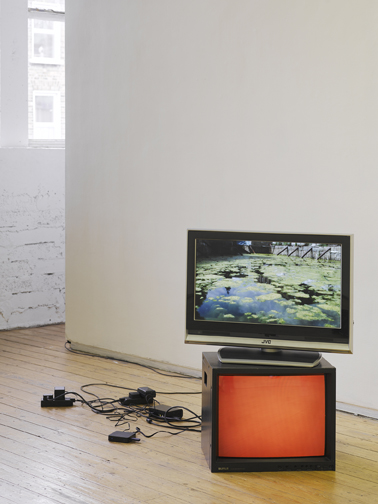 Dennis McNulty: Deepwater Horizon (2010),
Dennis McNulty: Deepwater Horizon (2010),
Dual video loops and monitors;
image courtesy the Green on Red. Photo: Ros Kavanagh.
Furthermore, these blurred photographic images and the video piece of an excavated, flooded and abandoned Dublin building site titled Deepwater Horizon, bring the work into the realm of a compulsive personal essay, using architecture and the nomadic revisiting of modernity as a means to convey the complexity of the contemporary moment.[7]
Deepwater Horizon is comprised of two televisions, one placed upon, and at a slight angle to, the other. The lower television’s bulky, retro screen beams continuous red, whereas the upper, slimmer television shows different aspects of this drowned building site in a pensive manner that, for a moment, slows and balances the otherwise constant spatial, temporal and cognitive shifting. And it is in these moments, wherever they may particularly occur, that the cumulative and coherent thrust of the overall work appears.
Adrian Duncan lives and works in Dublin.
_________________________________________________________________
[1] Green on Red Press Release, 2010.
[2] The Guardian, 2010, http://www.guardian.co.uk/science/2010/sep/29/earth-like-planet-gliese-581g.
[3] The Emancipated Spectator, Jacques Ranciére, 2004.
[4] Modern Architecture, A Critical History, Kenneth Frampton, Thames and Hudson, 4th Edition 2007, pg. 240.
[5] Waites Houses – Heritage Assessment, 2006 pg 4.
[6] Ibid.
[7] Green on Red Press Release, 2010.

